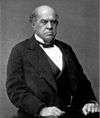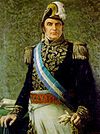
The Argentine Confederation was the last predecessor state of modern Argentina; its name is still one of the official names of the country according to the Argentine Constitution, Article 35. It was the name of the country from 1831 to 1852, when the provinces were organized as a confederation without a head of state. The governor of Buenos Aires Province managed foreign relations during this time. Under his rule, the Argentine Confederation resisted attacks by Brazil, Bolivia, Uruguay, France and the UK, as well as other Argentine factions during the Argentine Civil Wars.
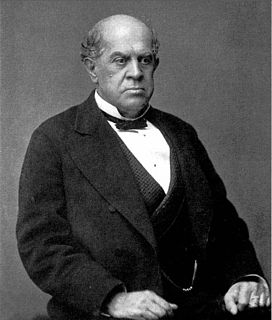
Domingo Faustino Sarmiento was an Argentine activist, intellectual, writer, statesman and the seventh President of Argentina. His writing spanned a wide range of genres and topics, from journalism to autobiography, to political philosophy and history. He was a member of a group of intellectuals, known as the Generation of 1837, who had a great influence on nineteenth-century Argentina. He was particularly concerned with educational issues and was also an important influence on the region's literature.
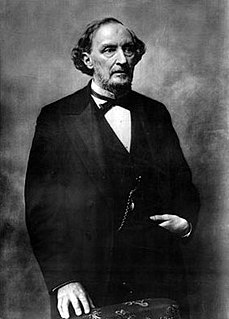
Bartolomé Mitre Martínez was an Argentine statesman, military figure, and author. He was the President of Argentina from 1862 to 1868.

Nicolás Remigio Aurelio Avellaneda Silva was an Argentine politician and journalist, and president of Argentina from 1874 to 1880. Avellaneda's main projects while in office were banking and education reform, leading to Argentina's economic growth. The most important events of his government were the Conquest of the Desert and the transformation of the City of Buenos Aires into a federal district.

Vicente Fidel López was an Argentine historian, lawyer and politician. He was a son of writer and politician Vicente López y Planes.

The Battle of Pavón was a key battle of the Argentine civil wars. It was fought in Pavón, Santa Fé Province, Argentina on 17 September 1861, between the Army of the State of Buenos Aires, commanded by Bartolomé Mitre, and the Army of Republic of the Argentine Confederation commanded by Justo José de Urquiza. The withdrawal of Urquiza left the field to Mitre.

The Domingo Faustino Sarmiento Railway (FCDFS), named after the former Argentine president, statesman, educator, and author Domingo Faustino Sarmiento, is one of the six state-owned Argentine railway divisions formed after President Juan Perón's nationalisation of the Argentine railway network in 1948. The six companies were managed by Ferrocarriles Argentinos which was later broken up during the process of railway privatisation beginning in 1991 during Carlos Menem's presidency.

Ricardo Ramón López Jordán (1822–1889) was an Argentine soldier and politician, one of the last influential "caudillos" in the history of Argentina. He thrice rebelled against the government of Buenos Aires and was defeated in each attempt.
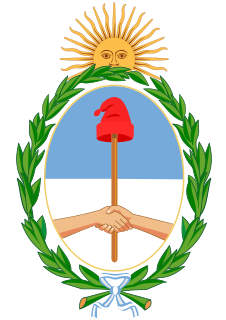
Argentina held nine presidential elections between 1862 and 1910, every six years.

Salvador María del Carril was a prominent Argentine jurist and policy-maker, as well as his country's first Vice President
The Cañuelas Pact was an agreement signed on 24 June 1829 between generals Juan Lavalle and Juan Manuel de Rosas, with the aim of ending the civil war in Buenos Aires Province, Argentina, which had been going on since the revolution of December 1828.

Historia de San Martín y de la emancipación sudamericana is a biography of José de San Martín, written by Bartolomé Mitre in 1869. Along with his biography of Manuel Belgrano, it is one of the earliest major works of the historiography of Argentina.
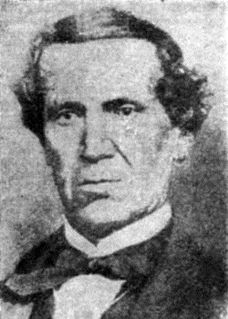
Manuel José Gómez Rufino was an Argentine politician who was governor of San Juan Province, Argentina between 1857 and 1858 and again between 1873 and 1874.
Events in the year 1868 in Argentina.

Del Parque is a former train station in Buenos Aires, Argentina. It was the first railway station in the country, serving as terminus of Buenos Aires Western Railway. The station was located at the intersection of Cerrito and Tucumán streets.

The Argentine presidential election of 1862 was held on 4 September to choose the first president of Argentina. Bartolomé Mitre was elected president.
The Argentine presidential election of 1874 was held on 12 April to choose the president of Argentina. Nicolás Avellaneda was elected president.
The Argentine presidential election of 1880 was held on 12 April to choose the president of Argentina. Julio Argentino Roca was elected president.
The Argentine presidential election of 1898 was held on 10 April to choose the president of Argentina. Julio Argentino Roca was elected president for a second period.

